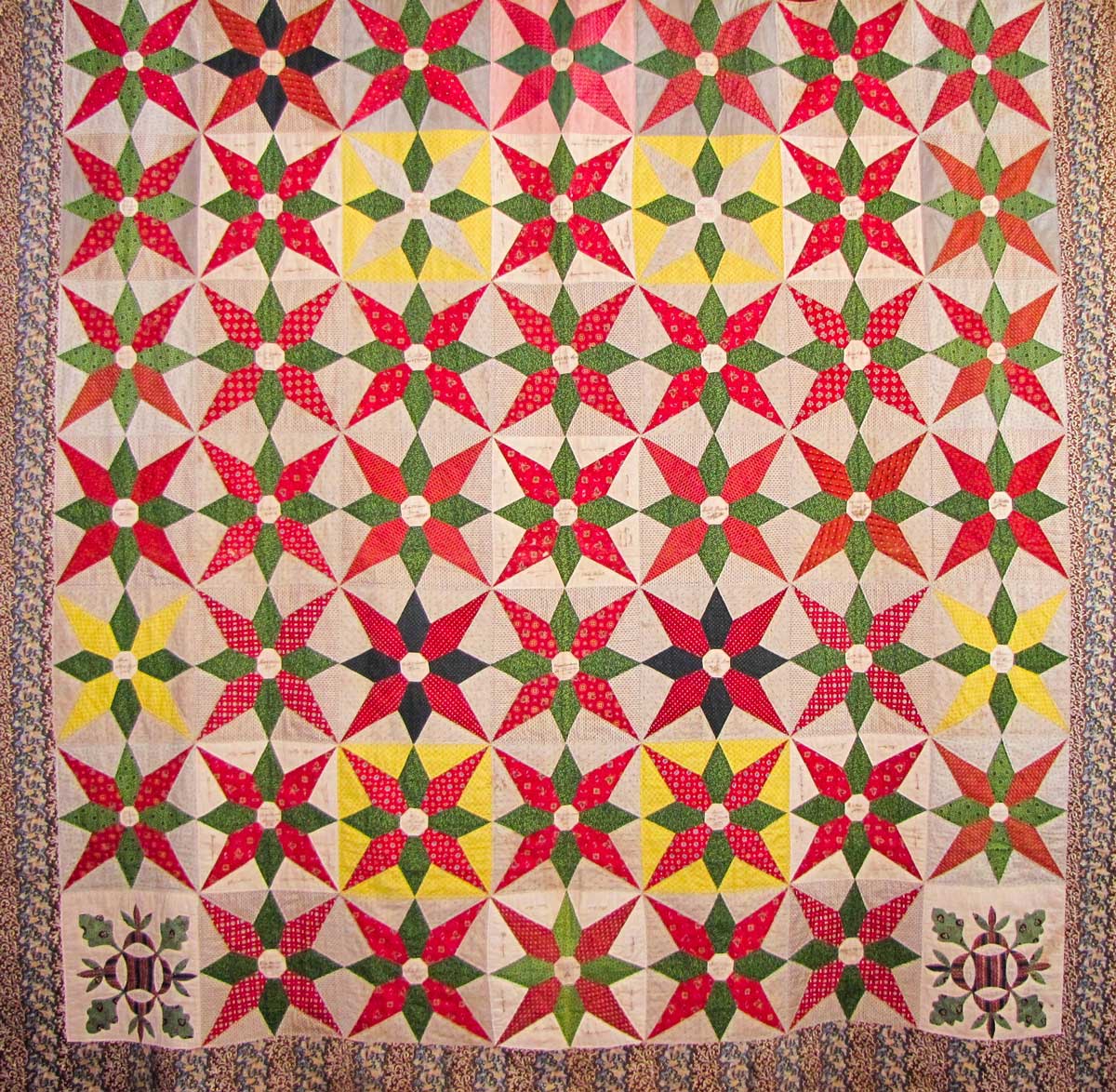Top Tips for Antique Quilt Collecting, Part II
August 2025
Covering Quilts
Top Tips for Antique Quilt Collecting, Part II
by Sandra Starley
Knowledge is power
With all the online resources available today, it is easy to become an educated consumer. It just takes some determination and time to develop your eye. It can be quite fun to learn history through quilts. Nothing is better than looking at beautiful quilts and learning their stories online and in person. I love to share my collection in antique quilt trunk shows and quilt study classes and I am available to bring my treasures to you.
The American Quilter’s Society quilt appraisal classes are another terrific way to learn about antique quilts and their value. The program’s reading list is a comprehensive resource for your own self-study course in quilt dating and history. The American Quilt Study Group is the best quilt history group with wonderful networking and amazing education seminars. There are also several antique quilt Facebook groups that are like a daily masterclass in quilt history.
Buyer beware
Unfortunately, there are sellers who try to pass off mass-produced Chinese imports as antiques, and since so many imports were made (and are still being made), you need to learn how to recognize them. A few quick clues: no applied binding on edges, large quilting stitches, and matching pillow shams.
Uneducated sellers often unintentionally misrepresent their items especially if they do not deal in textiles. This can work in your favor; just as there are 1930s Grand-mother’s Flower Garden quilts being billed as an 1800s treasure, there are actual 1830s quilts being labeled as Depression-era quilts. You can also learn a great amount by following reputable knowledgeable dealers. Reading their item listings and descriptions on eBay, Etsy, Ruby Lane, Instagram, and on their websites is a fantastic way to learn. Several dealers have released highly informative books about their collections.
Move onward and upward
Your interests will likely change over time and as you grow and mature as a collector. You will probably make a few missteps along the way as you develop your collector’s eye and see what is truly still out there to collect. It is sometimes hard to believe how many amazing quilts there are that have not yet been discovered. Quilts are still coming into the market from family collections, private collections, and even being released from museums. Savvy museums call it de-accessioning and sell off some of their quilts to upgrade, raise funds, fine-tune focus, etc. So follow their lead and let some earlier quilts go to beginning collectors and use the money to improve your own collection.

Worrall family quilt, Chester County, PA, 1850, from the Starley Quilt Collection. (Image courtesy of the author)
Document the journey of you and your quilts
Another key step is to keep track of your purchases and document when the item was bought, from whom, the purchase price, information given, along with photographs. Also leave space to add information that you learn through later research.
It is so much easier if you get a folder and add this material as you go (use both physical and online folders). This will be an invaluable tool if you want to do trunk shows or exhibits or want to sell quilts. People love to learn the history of quilts and always want to know “who made that quilt,” so be sure to keep track of as much of that information as you can. A quilt that seemed fairly generic to you five years ago may now stand out as a Pennsyl-vania German quilt or a Southern Quilt based on your increased knowledge. Be sure to note that in your records.
And don’t forget to have FUN!
Sandra Starley is nationally certified quilt appraiser, quilt historian, and avid antique quilt collector. She travels throughout the U.S. presenting talks on antique quilt history, fabric dating classes and trunk shows as well as quilting classes. Learn more at utahquiltappraiser.blogspot.com. Send your comments and quilt questions to SandraStarley@outlook.com
The Rolling Stone Quilt Pattern
November 2023 Covering Quilts The Rolling Stone Quilt Pattern by Sandra Starley As I noted in last month’s column, the Rolling Stone block is a classic early pattern that has been popular for more than 170 years. Part of its appeal is the simple, aka easy piecing:...
Rolling Stone Revisited
October 2023 Covering Quilts Rolling Stone Revisited by Sandra Starley Rolling Stone is a classic early quilt pattern that has been gaining popularity for more than 170 years. The block can be constructed in two separate ways: as an even or uneven nine patch. Both...
French Star or American Star revisited
September 2023Covering Quilts French Star or American Star revisited by Sandra Starley One of my all-time favorite antique quilt patterns is the French Star. I love sharing information about the block and hope to uncover more antique quilts featuring this design. I...
Still crazy after all these years! Crazy Quilts – Part II
August 2023Covering Quilts Still crazy after all these years! Crazy Quilts - Part II by Sandra Starley Crazy Quilts have been an iconic part of quilt history since the 1800s. Similarly, Discover Vintage America has been a sustained force in antiques and history since...
Crazy quilts showcase beauty in irregularity
July 2023 Covering Quilts Crazy quilts showcase beauty in irregularity by Sandra Starley What do a Victorian parlor, a Wizard of Oz char-acter, and a Batman villain have in common? Crazy Quilts! From ladies’ magazines in the 1880s to The Patchwork Girl of Oz in...
Classic patterns made modern – Rocky Road to Kansas
June 2023Covering Quilts Classic patterns made modern – Rocky Road to Kansas by Sandra Starley Last month, I wrote about the origins of the classic antique quilt pattern, Rocky Road To Kansas. While it sounds like a design dating back to the pioneer days of...

